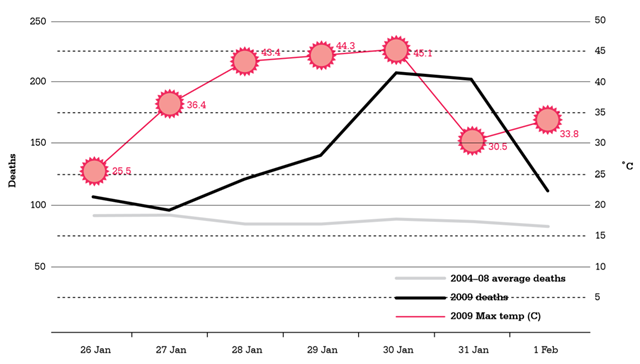Graph of the Day: Mortality and temperature during the 2009 Melbourne heatwave
(Climate Commission) – Very hot days and heatwaves have a significant impact on human health, infrastructure, agriculture and natural ecosystems. Research at the Natural Hazards Research Centre (NRHC) has shown that heatwaves are the most significant natural hazard in Australia in terms of loss of life. There have been 4287 fatalities directly attributable to heatwaves during the period 1803-1992 (Coates, 1996). Humans can survive only when core body temperature remains in a narrow range around 37°C (Hanna et al., 2011). If the body produces or absorbs more heat (for example, from physical activity or high air temperatures) than it can remove through direct transfer to the surrounding air or through sweating, core body temperature will rise. If core body temperature exceeds 38°C for several hours, the body can suffer heat exhaustion and reduced mental and physical capacity (Parsons, 2003; Berry et al., 2010). Serious heatstroke and even death can occur after a relatively short time if core body temperature goes above 42°C (Parsons, 2003). Children, the elderly, people with existing health issues and workers with heat-exposed jobs are the most vulnerable to extreme heat. Over the last decade, severe heatwaves around Australia have resulted in deaths and in increased hospital admissions for heart attacks, strokes, kidney disease and acute renal failure. During the severe heatwaves in southeastern Australia in 2009, Melbourne experienced three consecutive days at or above 43°C in late January. There were 980 heat- related deaths during this period, 374 more than would have occurred on average for that time of year (DHS, 2009; Figure 2). During the Brisbane heatwave of 7-26 February 2004 the temperature ranged from 26° to 42°C. Overall deaths increased by 23% (excluding injury and suicide) compared with the death rate during the same period in 2001-2003, when the temperature ranged from 22°C to 34°C (Tong et al., 2010). Longer-term trends in the impacts of extreme heat have also been observed. In Adelaide, from 1993 to 2006 an increase in total hospital admissions of 7% was recorded during heatwave periods compared with non-heatwave periods, and the number of people requiring ambulance transport during heatwaves increased by 4% (Nitschke, et al., 2007).
